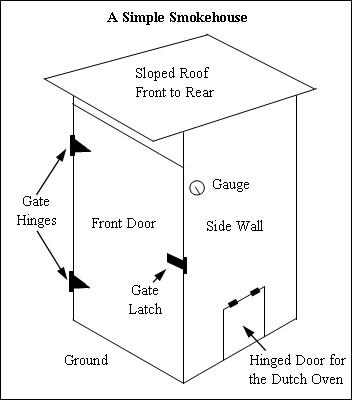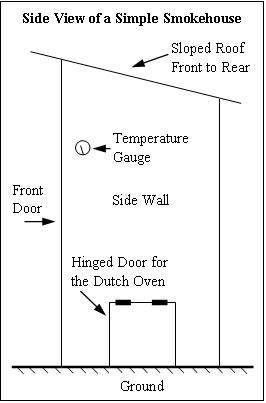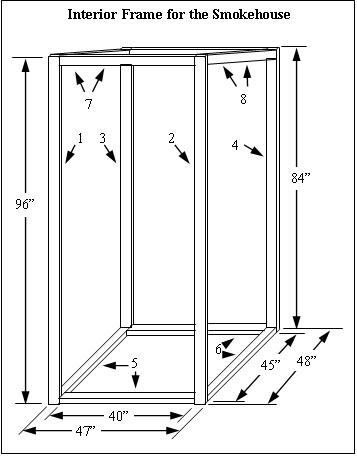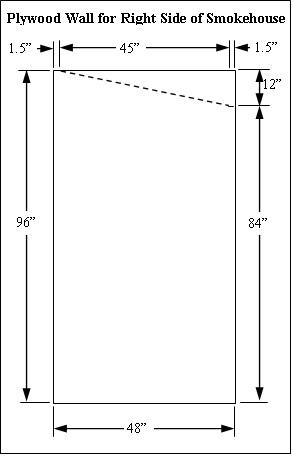
















How to Build a Simple but Extremely Practical Smokehouse
Copyright © May 1, 2012 by Robert Wayne Atkins, P.E.
All Rights Reserved.
Preface
The following information is Chapter 39 of my 166 page book: How to Tan Animal Hides and How to Make High Quality Buckskin Clothing.
Introduction
A simple smokehouse is strongly recommended for smoking meat and for smoking hides.


The following minimum materials would be required to build a simple smokehouse:
- Five sheets of 4 foot by 8 foot plywood that is between 1/2 inch to 3/4 inch thick.
- Eight 8 foot long 2x4 boards to build the interior frame for the smokehouse.
- Some 3 inch long nails to build the interior frame.
- Some 1.5 inch long nails to nail the plywood to the interior frame.
- Some waterproof sealant for the wood and a paintbrush.
- One metal latch (gate latch) that can be used to open and close the front door.
- Two heavy-duty hinges (gate or door hinges) for the front door.
- Two medium-duty door hinges for the lower side wall door.
- One oven or meat temperature gauge with a scale that will read between 100ºF to 200ºF (or higher).
- One Dutch oven or a heavy-duty steel pot with a lid.
- A flat rock or a patio stone to place beneath the Dutch oven inside the smokehouse.
- Some wires that can be strung between the walls on the inside of the smokehouse.
How to Build the Interior Frame of the Smokehouse
Do not use pressure treated wood to build the interior frame of the smokehouse. Pressure treated wood contains chemicals that will contaminate any meat that is smoked inside the smokehouse. Use ordinary interior grade 2x4 lumber for the interior frame. Also use interior grade plywood for the walls that will be nailed to the interior frame.
The five sheets of plywood will need to be cut as follows:
- Plywood Front Door: Cut the plywood 78" high. Leave the plywood 48” wide. Save the 18” piece of plywood that you cut off in addition to the 78” high door.
- Plywood Rear Wall: Cut a straight line so the plywood is 83.75 inches tall instead of 84 inches tall. The 1/4 inch will allow the roof plywood to rest on the 2x4 interior frame for support instead of the rear plywood wall.
- Plywood Right Side Wall: Lay the plywood on the ground with the good side of the plywood facing up towards you. Use a pencil to mark the top edge of the plywood as shown in the illustration on the above right. The first 1.5 inches at the top left will be nailed to a 1.5 inch wide 96 inch tall 2x4 board so it will remain straight. The 1.5 inches on the right side of the plywood that is 12 inches below the top of the plywood will be nailed to a 1.5 inch wide 84 inch tall 2x4 board so it needs to be straight to match the top of the 2x4 board. Now draw a straight line between the two 1.5 inch wide marks. Cut the top right of the plywood along the 1.5 inch right mark to a depth of 1.5 inches and stop. Now cut the top of the plywood along the straight line that you just drew beginning 1.5 inches from the left edge of the plywood and cutting down until you reach the 1.5 inch long straight cut that you made 12 inches down from the top of the plywood.
- Plywood Left Side Wall: Lay one uncut piece of plywood against the piece of plywood you just cut so that the good side of both pieces of plywood are touching one another. Use a pencil to mark the uncut piece of plywood across its top using the cut piece of plywood as your template. Then cut the new piece of plywood in the same manner as before along the lines you just drew.
- Plywood Roof: Cut the plywood 78” long. This will allow the roof plywood to extend off the front and the rear of the smokehouse so rainwater will flow off the rear of the smokehouse onto the ground.


The interior wood frame should be built using 8 foot long 2x4 lumber and some 3 inch long nails. Each piece of 8 foot long lumber should be cut to the following lengths:
The dimensions given for boards 5 through 8 below are based on 1/2 thick plywood. The plywood on the front and rear walls will extend 1/2 inch past the edge of each of the two side walls and cover the edges of the plywood on the two side walls. Therefore the side walls will be 49 inches from front to rear because they will include an additional 1/2 inch in the front and in the rear for the plywood on the front and rear walls.
If you use plywood of a thickness other than 1/2 inch then adjust the 40 inch cuts below as follows:
3/8" thick plywood walls: Cut 40.25" not 40".
5/8" thick plywood walls: Cut 39.75" not 40".
3/4" thick plywood walls: Cut 39.50" not 40".
Board 1: Do not cut. Leave at 8' (96") long.
Board 2: Do not cut. Leave at 8' (96") long.
Board 3: Cut 84 inches long for rear wall.
Board 4: Cut 84 inches long for rear wall.
Board 5: Cut 40 inches and 45 inches.
Board 6: Cut 40 inches and 45 inches.
Board 7: Cut 40 inches and 45 inches.
Board 8: Cut 40 inches and 45 inches.
The four boards on the bottom of the frame that will be in permanent contact with the ground should be coated with waterseal sealant using a paintbrush. This will help to protect and preserve those boards so they will last longer.
The four boards on the bottom of the frame (cut from boards 5 and 6) should be laid flat with their 3.5 inch wide surface touching the ground. Then the four upright wall boards (boards 1, 2, 3, and 4) should be positioned in each of the corner locations as shown. Coat the bottom surface of the upright wall boards with some waterseal sealant to help protect and preserve them. However, do not coat the entire upright board from top to bottom. Only coat the bottom 2 inches of the board with some waterseal sealant.
Nail the bottom of the frame together and nail the bottom of the four upright boards to the bottom of the frame as shown in the illustration.
The top four boards of the frame will be positioned with their 3.5 inch wide surface facing up and down. This is exactly opposite to the way the four bottom boards were attached to the frame. The four bottom boards were positioned with their wide side facing the ground but the four top boards will be positioned with their wide side facing into the interior of the smokehouse.
At the bottom of a side wall there should be a swinging door that you can open to add wood to the fire pot.
Smokehouse Equipment
- A meat thermometer should be inserted through the wall of the smokehouse so you can read the temperature dial from the outside of the smokehouse to let you know when to add more wood to the fire. Or you can use a charcoal grill or a gas grill thermometer instead of a meat thermometer.
- A cast iron Dutch oven (size at least 6 quarts) should be used to contain the fire. The lid will allow you to control the burn by letting more or less air to the burning wood. The Dutch oven should be placed on top of a large flat rock, or a flat patio stone, about 12 inches from the small door opening at the bottom of the smokehouse.
- Wires should be strung horizontally (level) from front to rear, or from side to side, inside the smokehouse near the ceiling to hang hides or meat on.
The Fire
Start a small fire inside the Dutch oven using some small extremely dry sticks. Gradually add a few chucks of dry wood. Continue to add small chucks of dry wood until you have a nice bed of red hot coals about one inch deep in the bottom of the Dutch oven. Now you may add some very dry decayed wood, or any wood that smokes well, on top of the hot coals inside the Dutch oven and immediately place the lid on top of the Dutch oven so there is only a small opening on one side of the lid to allow air to enter the oven and heat and smoke to exit the oven.
It is now time to leave the smokehouse and close the smokehouse door behind you.
You may notice some of the smoke (and heat) escaping from the smokehouse around the edge of the roof where it is attached to the smokehouse.
The smoke should gradually become thick and dense inside the smokehouse. The thicker the smoke the better. You want maximum smoke and just the right amount of heat but no moisture.
Precautions
Do not smoke meat for human consumption at the same time you are smoking hides.
The smokehouse should not be air tight. The smokehouse should allow some of the heat to escape. Too much heat will cook your meat and your hides and ruin them.
Different Types of Wood
Avoid moisture in the wood and in the fire.
Freshly cut wood is called "green wood" because it still contains moisture and it has not dried yet. Wood that contains moisture will smoke extensively when it is burned. For this reason most firewood is allowed to season, or dry, before it is used in a wood burning fireplace because dry wood will produce more heat and very little smoke.
Avoid any wood that contains pitch, such as pine, because the pitch will be in the smoke and the pitch will therefore get into the hide (or meat) and the hide will feel sticky and somewhat stiff after smoking.
The best wood to use to create smoke is semi-rotten wood. Semi-rotten wood is called "punky" wood. Dry corncobs or dry leaves or dry sawdust may also be used to create smoke.
Different types of wood yield different amounts of heat and smoke. In other words, some types of wood burn hotter and some woods create more or less smoke than other types of wood. Therefore it is not possible to establish the exact amount of time that a hide needs to be smoked.
The thickness of the wood chips should be between 1/2 inch to 3/4 inch. The width of the chips should be between 1 to 2 inches. The length of the wood chips should be based on the size of your Dutch oven. The wood chips should be at least one inch shorter than the minimum inside diameter of your Dutch oven.
Save the sawdust you create when you are cutting your wood and your wood chips. A little dry sawdust dropped onto hot coals will produce a good quantity of smoke for the smoking process.
The more time that a hide is smoked the darker in color the hide will gradually become. If the hide is relatively white to begin with then it will gradually turn yellow, then orange, and then light brown as the smoking time is increased.
Optional Painting of the Exterior of a Smokehouse
A coat of exterior house paint that is applied to the exterior of a smokehouse will achieve two objectives:
- Protection: It will protect the smokehouse from the weather and extend its useful life expectancy.
- Temperature Control: It will either increase or decrease the temperature inside the smokehouse when the sun is shinning, even when there is no fire burning inside the smokehouse. The two basic color choices are black and white:
- Black: Black will absorb the heat from the sun and the temperature inside the smokehouse will be warmer than if the smokehouse was not painted. If you live in the northern United States, or in any area where the winters are relatively long and cold, then a black color will absorb the sun’s energy and increase the temperature inside the smokehouse on a bright sunny day.
- White: White will reflect the heat from the sun and the temperature inside the smokehouse will be cooler than if the smokehouse was not painted. If you live in the southern United States, or in any area where the winters are relatively short and mild, then a white color will help to reflect the sun’s energy and minimize the temperature inside the smokehouse on a bright sunny day.
Temperature control is an extremely important factor when smoking meat and when smoking hides. In both situations the temperature inside the smokehouse needs to be kept within a narrow range so that the meat or the hides are properly smoked and they are not cooked.
Smokehouse Construction
The smokehouse can be built in one day, if the area where the smokehouse will be constructed is ready to receive the smokehouse. The smokehouse requires a space of approximately 4 feet wide from side to side and 5 feet deep from front to rear. For safety reasons it should be at least ten feet away from any other structure on your property. It should also be at least ten feet away from any trees or shrubs. Finally, the area around the outside of the smokehouse should be short grass, or dirt, or gravel, or stone.
The above information is Chapter 39 of my 166 page book: How to Tan Animal Hides and How to Make High Quality Buckskin Clothing.
Respectfully,
Grandpappy.
Grandpappy's e-mail address is: RobertWayneAtkins@hotmail.com









































